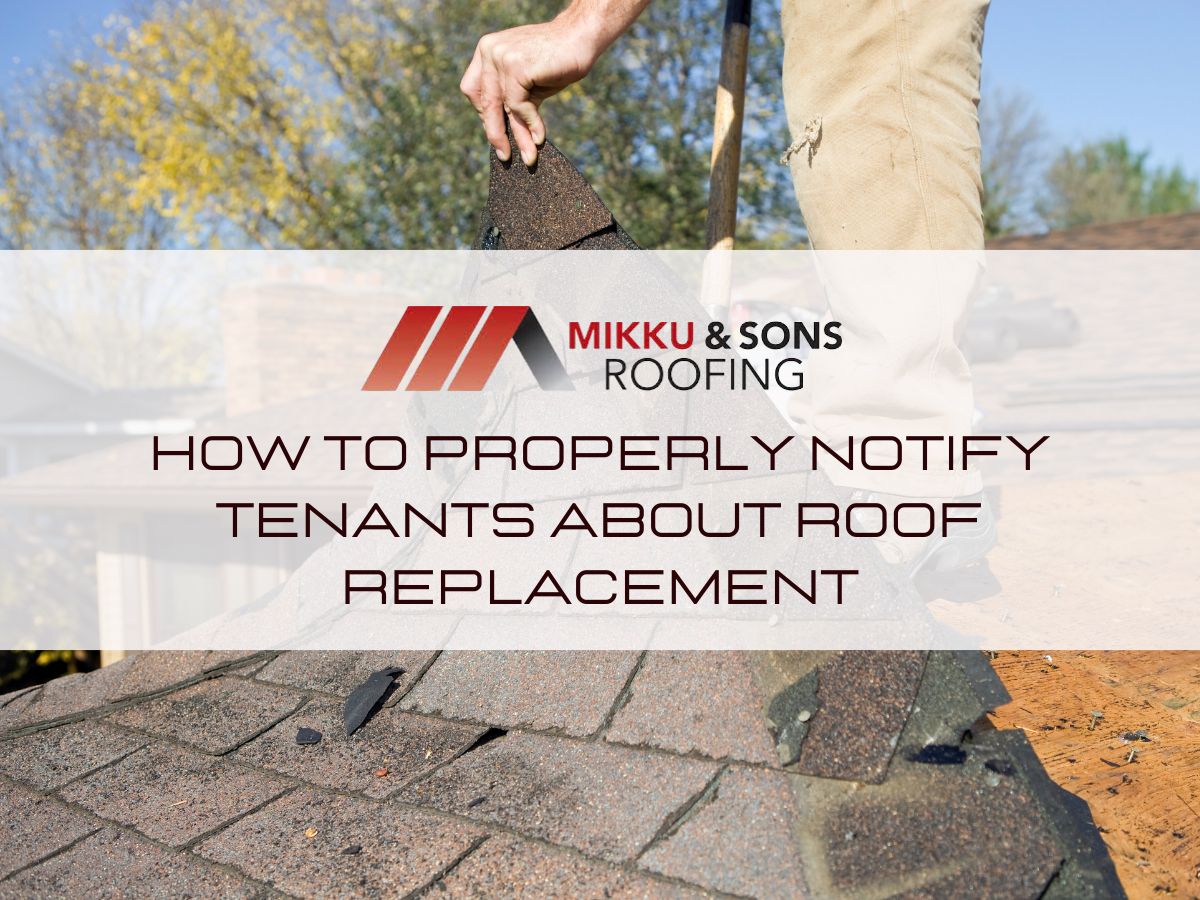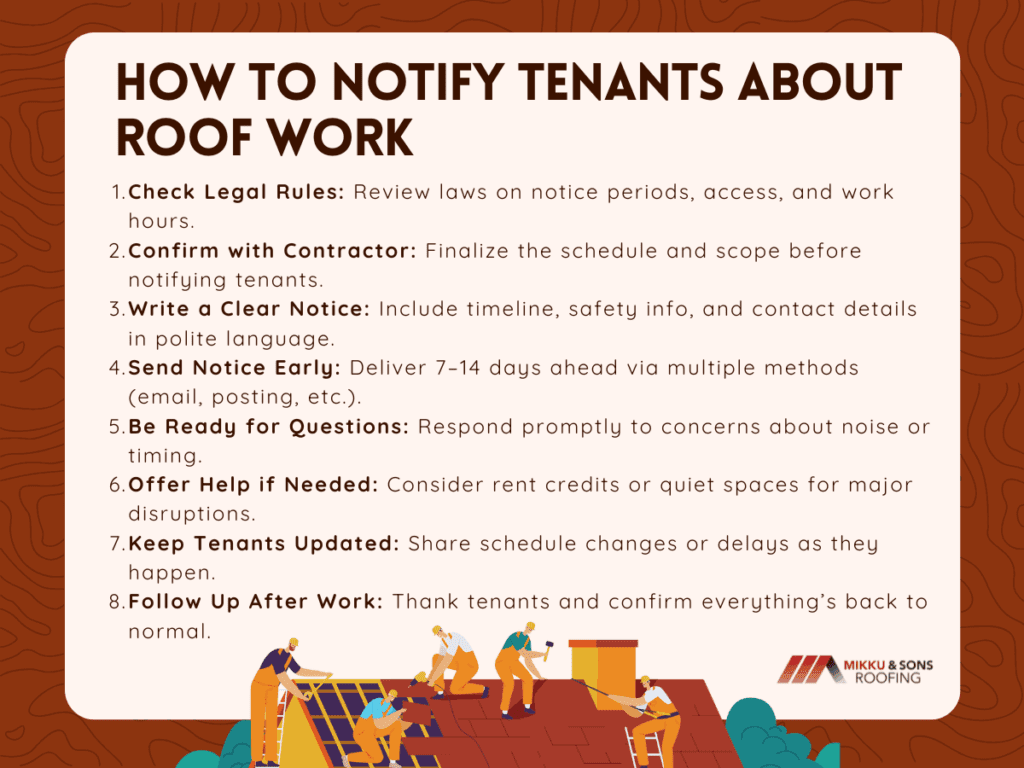

To properly notify tenants about roof replacement, landlords should provide a clear, timely, and legally compliant written notice that outlines the scope, schedule, and impact of the project. This communication should be delivered well in advance, using appropriate methods, to ensure tenants are informed, prepared, and able to take necessary precautions during the construction period.
This article highlights the importance of proper notification, outlines key elements to include, suggests effective delivery methods, and provides a sample notice. It also covers legal considerations to help ensure compliance and maintain positive tenant relations.
Properly notifying tenants about a roof replacement is more than a courtesy—it’s a legal and practical necessity. Clear communication helps prevent misunderstandings, reduces complaints, and ensures a smoother renovation process for both tenants and property managers.
Most local landlord-tenant laws require advance notice for major repairs like roof replacements. Failing to provide proper notice can result in fines, legal disputes, or tenant claims of lease violations.
Roof work involves equipment, debris, and restricted access areas that can pose safety risks. Informing tenants ahead of time allows them to take precautions, especially for children, pets, and anyone with mobility concerns.
Roof replacement can be noisy and intrusive. Advance notice gives tenants time to adjust schedules, plan around disruptions, and avoid frustration.
Transparent and respectful communication fosters trust and shows tenants that their comfort and safety are a priority. This can lead to higher tenant satisfaction and retention.
Letting tenants know what to expect—such as noise levels, work hours, or access restrictions—prevents confusion and helps them prepare accordingly.
Providing proper notice ensures the roof replacement process goes smoothly and respectfully. It protects both landlords and tenants while promoting a cooperative living environment.
A well-crafted roof replacement notice keeps tenants informed, respected, and prepared. Including clear, relevant details reduces confusion, builds trust, and helps ensure a safe and organized project.
Including these elements ensures your notice is clear, complete, and respectful—laying the foundation for a smooth and successful roof replacement.
Properly notifying tenants of a roof replacement project involves more than sending a quick note—it's a structured process that ensures clarity, compliance, and cooperation. By following these steps, landlords can minimize disruptions, maintain trust, and complete the project with fewer issues.

Start by checking local and state landlord-tenant laws regarding notice periods, access rights, and construction hour regulations. This ensures your notice is legally compliant and protects you from potential disputes.
Before notifying tenants, finalize the roof replacement schedule, scope of work, and estimated duration with your contractor. Understanding the logistics will help you provide accurate and detailed information in the notice.
Coordinating your project scheduling clearly; including start dates, estimated completion windows, and daily work hours; helps landlords set expectations and avoid confusion before, during, and after tenant notifications.
Write a professional notice that includes all essential information: project timeline, affected areas, safety guidelines, and contact details. Use clear, respectful language and keep the tone informative and courteous.
Send the notice well in advance—ideally 7 to 14 days before work begins—even if local laws require less. Use multiple delivery methods such as hand delivery, email, and posting in common areas to ensure all tenants receive it.
Be ready to address tenant feedback and questions promptly and respectfully. Having clear answers about timelines, noise levels, or access issues can prevent frustration and build tenant confidence.
If the work will cause significant inconvenience, consider offering small accommodations such as rent credits, alternative parking, or quiet zones for remote workers. These gestures show good faith and can reduce tenant complaints.
Stay in touch with tenants during the project, especially if there are delays or changes to the schedule. Timely updates help manage expectations and show tenants that you're being proactive.
Accurate time-keeping of crews and labor progress helps property managers track how long each phase of the roof replacement takes, making updates to tenants more transparent and reliable.
Once the project is finished, follow up with tenants to confirm that everything is back in order. A brief thank-you message and any necessary cleanup notes reinforce professionalism and tenant care.
Notifying tenants of a roof replacement requires planning, transparency, and good communication. By taking these steps, landlords can complete essential maintenance while preserving positive tenant relationships and ensuring a safe, respectful environment.
Choosing the right way to deliver a roof replacement notice ensures tenants are informed and understand what to expect. Using multiple methods improves reach and shows professionalism.
Using a mix of these methods helps ensure no tenant is left uninformed and supports a smooth, well-communicated project.
Having a ready-to-use template for roof replacement notifications can save time and ensure all critical information is communicated clearly. Below is a sample notice you can customize based on your property, schedule, and tenant needs.
| [Your Company/Property Name] [Company Address] [Phone Number] | [Email Address] Date: [Insert Date] Subject: Notice of Scheduled Roof Replacement at [Property Address] Dear [Tenant Name], We are writing to inform you that roof replacement work is scheduled to take place at your building located at [Property Address]. This essential maintenance is being done to improve the safety and long-term condition of the property. Work is scheduled to begin on [Start Date] and is expected to be completed by [End Date], weather permitting. Construction crews will be working between [Start Time] and [End Time] each day. During this time, you may experience elevated noise levels, temporary restrictions to certain areas (such as parking spaces, balconies, or entrances), and other minor disruptions. For your safety, please avoid entering any marked or restricted construction zones. We ask that pets and children be kept indoors or away from the work areas during this time. If access to any part of your unit becomes necessary, we will provide additional notice in accordance with your lease agreement and local regulations. If you have any questions or concerns, please don’t hesitate to contact [Property Manager's Name] at [Phone Number] or [Email Address]. We appreciate your patience and cooperation as we complete this important project. Sincerely, [Your Name] [Your Title] [Management Company Name] |
This sample template can be easily adapted for any rental property and helps ensure your notice is both professional and legally sound. Clear, respectful communication like this sets the tone for a positive experience during major maintenance projects.
Roof replacement projects in rental properties must follow legal guidelines and practical best practices to avoid disputes and ensure smooth execution. Proper planning helps protect both tenant rights and landlord responsibilities.
Laws often require landlords to give 24–72 hours' written notice before major repairs. For roof replacements, providing 7–14 days’ notice is a good practice to keep tenants informed.
If workers need to enter tenant units, landlords must follow legal entry requirements. Even exterior work should be clearly communicated in advance.
Landlords must maintain livable conditions during construction. If the work causes significant disruption, they may need to offer rent adjustments or temporary accommodations.
Ensure your contractor is licensed and insured to avoid liability for damages or accidents. Confirm your property insurance covers construction-related risks.
Tenants with disabilities may require special accommodations, like alternate access routes or extra notice. These must be considered under ADA and Fair Housing laws.
Follow local laws on construction hours and noise limits to prevent fines and complaints. Typical work hours are between 8 a.m. and 6 p.m.
Being mindful of legal and practical details ensures the roof replacement is handled professionally, safely, and in compliance with the law. This reduces risk and builds tenant trust.
Properly notifying tenants about a roof replacement is not just a courtesy—it’s a legal and practical necessity that promotes trust, transparency, and safety. A clear, timely, and detailed notification helps reduce confusion, prevent disputes, and ensure tenants feel informed and respected throughout the process.
By understanding the importance of notification, including all key elements, using effective delivery methods, and following legal requirements, landlords can manage the project professionally while maintaining positive tenant relationships. Thoughtful communication turns a disruptive project into a well-handled upgrade that benefits both property and residents.
